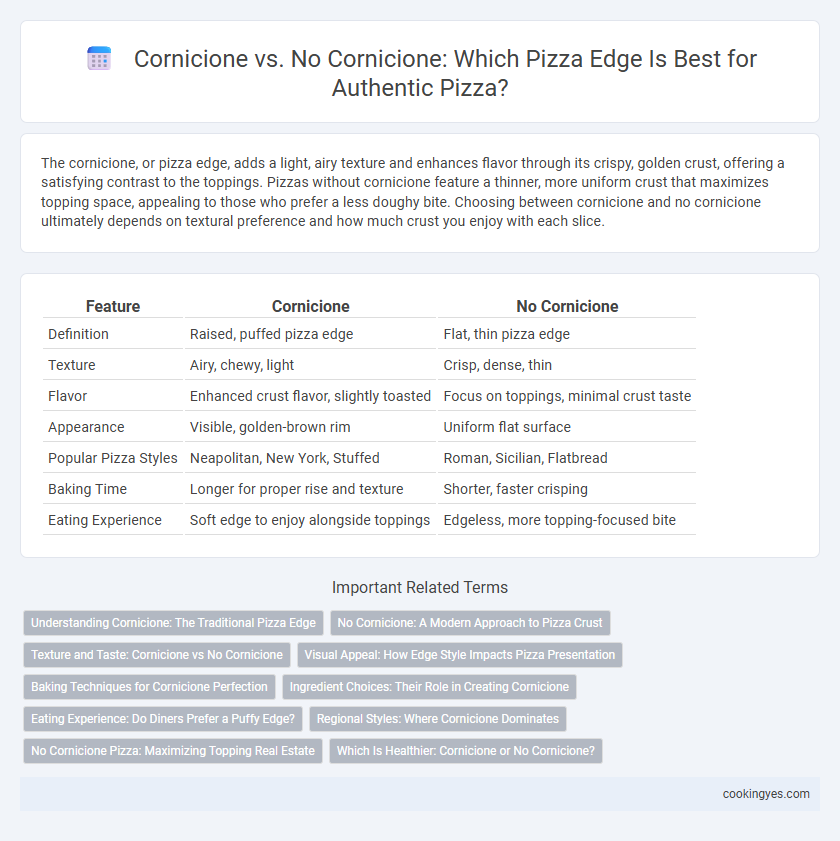The cornicione, or pizza edge, adds a light, airy texture and enhances flavor through its crispy, golden crust, offering a satisfying contrast to the toppings. Pizzas without cornicione feature a thinner, more uniform crust that maximizes topping space, appealing to those who prefer a less doughy bite. Choosing between cornicione and no cornicione ultimately depends on textural preference and how much crust you enjoy with each slice.
Table of Comparison
| Feature | Cornicione | No Cornicione |
|---|---|---|
| Definition | Raised, puffed pizza edge | Flat, thin pizza edge |
| Texture | Airy, chewy, light | Crisp, dense, thin |
| Flavor | Enhanced crust flavor, slightly toasted | Focus on toppings, minimal crust taste |
| Appearance | Visible, golden-brown rim | Uniform flat surface |
| Popular Pizza Styles | Neapolitan, New York, Stuffed | Roman, Sicilian, Flatbread |
| Baking Time | Longer for proper rise and texture | Shorter, faster crisping |
| Eating Experience | Soft edge to enjoy alongside toppings | Edgeless, more topping-focused bite |
Understanding Cornicione: The Traditional Pizza Edge
Cornicione refers to the raised, airy outer edge of a traditional Neapolitan pizza crust, characterized by its light, chewy texture and subtle charring from wood-fired ovens. This signature crust edge enhances flavor and provides a tactile contrast to the pizza's toppings, showcasing artisanal dough fermentation and baking techniques. Choosing cornicione over a no-cornicione edge reflects a commitment to authentic pizza craftsmanship and an elevated textural experience.
No Cornicione: A Modern Approach to Pizza Crust
No cornicione pizza edges offer a sleek, modern twist by eliminating the traditional thick crust border, resulting in a thinner, crispier edge that maximizes the toppings surface. This style appeals to health-conscious consumers seeking lower carbohydrate options and pizzerias aiming for a contemporary aesthetic. The no cornicione approach also enhances the balance of flavors, allowing sauces, cheeses, and toppings to shine without distraction from a bulky crust.
Texture and Taste: Cornicione vs No Cornicione
Cornicione, the raised outer edge of pizza crust, offers a light, airy texture with a crispy exterior that enhances the overall bite, providing a satisfying contrast to the softer interior. Pizzas without cornicione feature a thinner, uniform crust edge that results in a chewier texture and a more concentrated dough flavor. The presence of cornicione emphasizes a balance of textures and a subtle toasted taste, while no cornicione creates a straightforward, dough-forward experience.
Visual Appeal: How Edge Style Impacts Pizza Presentation
The cornicione, a thick and airy crust edge, enhances pizza's visual appeal by adding height and a rustic, artisanal look that draws attention. In contrast, a no cornicione edge creates a flatter, streamlined appearance, emphasizing the toppings and sauce for a minimalist presentation. Choosing between cornicione and no cornicione directly impacts pizza presentation by balancing texture visibility with topping focus.
Baking Techniques for Cornicione Perfection
Mastering the baking techniques for cornicione perfection involves controlling oven temperature and dough hydration to create a light, airy crust with crispy outer edges. Using high heat and steam during the initial baking phase ensures the cornicione puffs up properly, while longer fermentation develops flavor and texture. No cornicione pizzas require different baking adjustments focused on a uniform, thinner crust to avoid overcooking the edges.
Ingredient Choices: Their Role in Creating Cornicione
The cornicione in pizza relies heavily on high-protein flour and well-hydrated dough, which create the airy, chewy crust edge through gluten development and fermentation. Without these ingredient choices, such as lower hydration levels or different flour types, the crust remains thin and lacks the characteristic puffiness of a cornicione. Yeast quality, fermentation time, and precise salt content further influence the rise and texture of the cornicione, distinguishing it from pizzas with no raised edge.
Eating Experience: Do Diners Prefer a Puffy Edge?
Diners often favor a puffy cornicione for its airy texture and enhanced flavor, which adds a satisfying contrast to the pizza's toppings. The thicker edge provides a chewy bite that can hold seasoning or cheese, enriching the overall eating experience. Conversely, pizzas without a cornicione emphasize a consistent thin crust, appealing to those who prefer a uniform texture throughout their slice.
Regional Styles: Where Cornicione Dominates
In Neapolitan pizza, the cornicione is a defining feature, characterized by its thick, airy, and charred edge that results from high-temperature wood-fired ovens. This raised crust not only enhances texture but also traps flavor compounds, making it a regional staple in Campania, Italy. Contrastingly, Roman-style pizza typically opts for a thin, crispy edge without cornicione, reflecting local preferences for a more uniform and crunchy crust.
No Cornicione Pizza: Maximizing Topping Real Estate
No cornicione pizza maximizes topping real estate by eliminating the traditional raised crust edge, allowing for more surface area to place toppings evenly across the entire slice. This style enhances flavor distribution and provides a consistent bite from edge to center, appealing to lovers of loaded, fully topped pizzas. Without the cornicione, pizza makers can experiment with creative topping combinations without sacrificing space.
Which Is Healthier: Cornicione or No Cornicione?
Choosing between cornicione and no cornicione for pizza edges impacts nutritional value, as cornicione, the airy, thicker crust edge, often contains more carbohydrates and calories due to its dough volume. No cornicione results in a thinner, crispier edge with fewer calories, making it a healthier option for those monitoring calorie intake or carb consumption. However, the overall healthiness depends on the pizza toppings and portion size rather than just the presence or absence of cornicione.
Cornicione vs No cornicione for pizza edge Infographic

 cookingyes.com
cookingyes.com